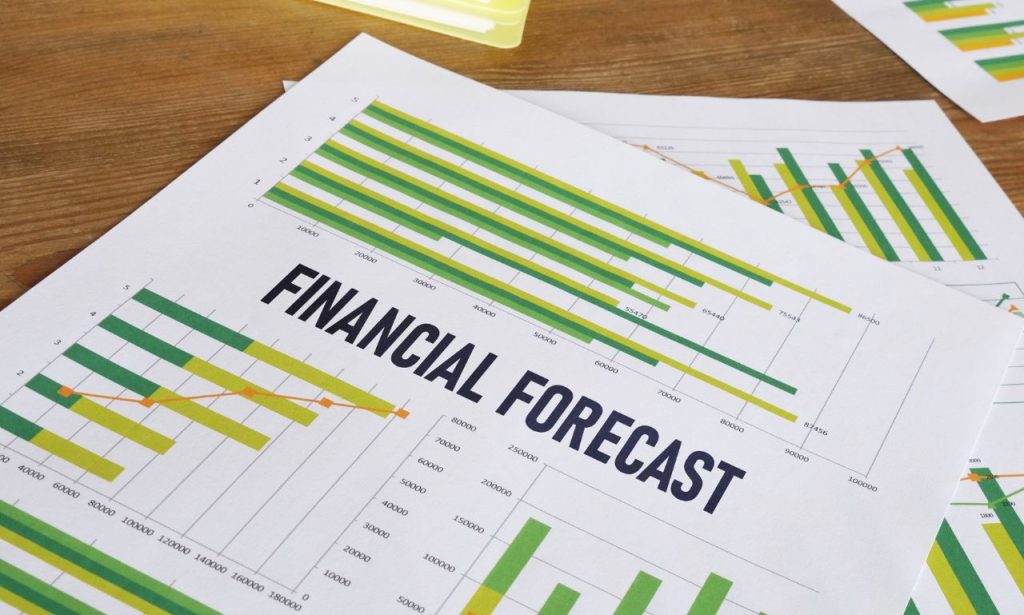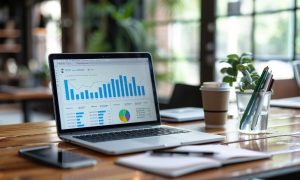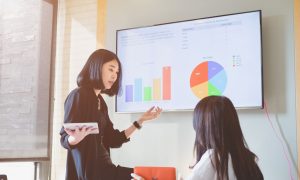Trend forecasting isn’t just about crystal balls and lucky guesses anymore. Today’s businesses need concrete strategies to predict what’s coming next. The companies that master forecasting are the ones that survive market shifts launch products at perfect timing and leave competitors scrambling to catch up.
This article covers everything from harnessing qualitative and quantitative data to implementing sophisticated trend management software. You’ll learn how cultural influences shape predictions, discover proven methods for tracking emerging patterns, and understand why some forecasts hit the mark while others miss completely. Whether planning your next product launch or trying to stay ahead of consumer demand, these insights will transform how you approach trend prediction.
Harnessing Qualitative and Quantitative Data
The best trend forecasters don’t pick sides between numbers and intuition. They combine both. Quantitative data gives you the hard facts – sales figures, search volumes, demographic shifts. But qualitative insights reveal the “why” behind the numbers.
Netflix didn’t just look at viewing statistics when it decided to invest billions in original content. Instead, it analyzed qualitative feedback about user frustration with licensing limitations. The data showed that people wanted consistent access to shows, not rotating availability. This insight led to the content strategy that dominates streaming today.
Smart forecasters use statistical methods like the X-11 for seasonal adjustments while conducting in-depth interviews with target consumers. Google Trends provides excellent quantitative baseline data, but focus groups reveal emotional drivers that numbers can’t capture.
The key is timing your data collection right. Quantitative methods work best for established patterns and historical trends, while qualitative approaches excel at spotting early signals of change. When Apple’s sales data showed declining iPad purchases, they didn’t just analyze the numbers. They studied how people actually used tablets in their daily lives, leading to the iPad Pro’s positioning for professional use.
The Role of Data in Predicting Future Consumer Needs

Consumer behavior follows patterns, but those patterns shift constantly. The challenge lies in distinguishing between temporary fluctuations and genuine long-term trends. Successful forecasters focus on leading indicators rather than lagging ones.
Take the rise of plant-based foods. Early trend forecasters didn’t wait for mainstream adoption. They tracked Instagram hashtags, monitored specialty restaurant openings, and analyzed demographic data about health consciousness among millennials. By the time Beyond Meat went public, innovative retailers had already secured shelf space for alternative proteins.
Historical trends provide context, but the consumer needs to evolve faster than ever. The average product lifecycle has shortened dramatically across industries. Fashion trends that once lasted seasons now change monthly. Tech adoption curves that took years now happen in months.
Modern forecasting requires real-time data processing. Companies like Zara revolutionized fashion by simultaneously tracking social media sentiment, street-style photography, and point-of-sale data. Their forecasting system can identify emerging style preferences and get new designs to stores within weeks.
The most reliable consumer needs predictions are based on observing behavioral changes rather than stated preferences. People often can’t articulate what they want until they see it. Instagram didn’t emerge from surveys asking people about photo-sharing needs. It succeeded because its founders observed how people naturally wanted to capture and share visual moments.
Refining Marketing Strategies with Trend Insights
Trend forecasting transforms marketing from reactive to predictive. Instead of chasing current trends, forward-thinking marketers position themselves ahead of the curve. This approach requires an ideal understanding of trend cycles and timing interventions.
Macro trends develop over the years, while micro trends can explode and fade within months. Your marketing strategy needs frameworks for both timeframes. Long-term positioning builds brand authority, while short-term trend capitalization drives immediate engagement.
Consider how outdoor gear companies prepared for the hiking boom during COVID-19. The most innovative brands didn’t wait for lockdowns to end. They spotted early signals in urban apartment searches, gym membership cancellations, and national park website traffic. They captured massive market share by pre-positioning inventory and messaging around outdoor exploration.
Seasonal factors still matter, but traditional patterns are breaking down. Black Friday shopping now starts in October, and holiday decorations appear earlier each year. Your forecasting models need to account for these shifting seasonal dynamics.
The most successful integration of marketing trends happens through systematic testing. Run small campaigns targeting predicted trend adoption, measure response rates, and scale successful approaches. This method reduces risk while maximizing upside potential when predictions prove accurate.
Driving Innovation through Forecasting
Innovation without forecasting is expensive experimentation. Companies that consistently launch successful products use trend prediction to guide their R&D investments. They don’t just react to current market needs—they anticipate future ones.
Tesla’s success illustrates perfect innovation forecasting. While other automakers focused on improving gas engines, Tesla’s founders predicted environmental consciousness would drive electric vehicle adoption. They invested heavily in battery technology and charging infrastructure years before mainstream demand.
Long-term forecasting benefits product concept development enormously. Understanding demographic shifts, technological capabilities, and cultural movements helps teams design solutions for tomorrow’s problems. The iPhone succeeded partly because Apple anticipated mobile internet usage would explode, even when most people still used flip phones.
Forecasting also prevents costly innovation mistakes. Many companies waste resources developing products for declining markets. Kodak’s massive digital camera investments came too late because they misread smartphone photography trends. Better forecasting would have revealed that phone cameras would replace dedicated devices for most consumers.
The best innovation forecasting combines multiple data sources. Patent filings reveal technological directions; university research indicates emerging scientific capabilities and venture capital funding patterns show where smart money expects growth. Combining these signals creates robust innovation roadmaps.
Overcoming Challenges in Trend Forecasting
Forecasters face common challenges: data overload, confirmation bias, and timing errors. The solutions require disciplined processes and honest assessment of prediction accuracy.
External factors constantly disrupt even the best forecasting models. Economic conditions, regulatory changes, and unexpected events can invalidate carefully constructed predictions. The COVID-19 pandemic upended virtually every trend forecast made in early 2020.
Building resilient forecasting requires scenario planning. Instead of predicting single outcomes, develop multiple potential futures and strategies for each. This approach helps companies adapt quickly when circumstances change unexpectedly.
Confirmation bias represents the biggest threat to accurate forecasting. Humans naturally seek information that supports existing beliefs while ignoring contradictory evidence. Combat this tendency through structured devil’s advocate processes and diverse forecasting teams.
Timing predictions present the most significant challenge. You might correctly identify an emerging trend but misjudge when it will gain mainstream adoption. Virtual reality provides a perfect example – technology has been “the next big thing” for over a decade, yet widespread consumer adoption remains limited.
Implementing Trend Management Software
Modern forecasting requires sophisticated tools to process massive data volumes and identify subtle patterns. Dedicated trend management software transforms raw information into actionable insights through advanced analytics and visualization.
The best platforms automatically integrate multiple data sources. Social media monitoring, sales analytics, economic indicators, and consumer research combine to create comprehensive trend dashboards. This integration eliminates manual data compilation and dramatically reduces analysis time.
Machine learning capabilities enhance pattern recognition beyond human capacity. Algorithmic analysis can spot correlations across seemingly unrelated datasets. For example, the software might connect increasing yoga studio memberships with rising quinoa sales, revealing broader wellness trend adoption.
However, technology alone doesn’t guarantee forecasting success. The software provides tools, but human judgment interprets results and makes strategic decisions. The most effective implementations combine automated data processing with experienced analyst interpretation.
Choose platforms that offer customizable reporting for different stakeholders. Executives need high-level trend summaries, while product teams require detailed consumer behavior analysis. Marketing departments want campaign-ready insights, and supply chain managers need demand projections.
Best Practices for Tracking and Validating Trends
Systematic trend tracking prevents necessary signals from getting lost in information noise. Establish clear trend identification, measurement, and validation criteria before analysis begins.
Track trends across multiple timeframes simultaneously. Daily monitoring catches viral phenomena; weekly analysis reveals emerging patterns and monthly reviews confirm long-term directions. Each timeframe requires different measurement approaches and response strategies.
Validation prevents false positive trend identification. Just because something appears growing doesn’t mean it represents a sustainable trend. Validate through multiple independent sources and look for supporting evidence across market segments.
Consumer simulation models help test trend predictions before committing resources. Run scenarios showing how different adoption rates would affect your business. Model best-case, worst-case, and most likely outcomes to understand potential impacts.
Regular accuracy assessment improves forecasting over time. Track which predictions proved correct, which failed, and why. This feedback loop identifies systematic biases and improves future prediction quality.
Considering Cultural Influences in Forecasting
Cultural factors shape trend adoption more than most forecasters realize. What succeeds in one geographic region or demographic group may fail in another. Understanding cultural context prevents costly expansion mistakes.
Generational differences affect trend timing and adoption patterns. Baby boomers and Gen Z consumers respond to completely different triggers. Social media trends that explode among younger demographics often never reach older consumers, while traditional media influences remain strong with certain age groups.
Regional variations require localized forecasting approaches. Urban and rural markets develop differently. International expansion demands an understanding of local cultural values, regulatory environments, and competitive landscapes.
Religious and ethnic considerations influence product acceptance and marketing messaging. Food trends particularly demonstrate cultural sensitivity requirements. Plant-based alternatives succeeded in secular markets but faced resistance in communities with strong meat-eating traditions.
Economic inequality affects trend adoption across income levels. Luxury trends often begin with affluent early adopters before trickling down to mass markets. Understanding this progression helps timing predictions and pricing strategies.
Staying Competitive in a Dynamic Market
Market dynamics accelerate constantly, making maintaining a competitive advantage increasingly challenging. Companies that master trend forecasting create sustainable differentiation through superior market timing and product positioning.
Competitive intelligence should inform forecasting models. Track competitor product launches, marketing campaigns, and strategic announcements. These signals often reveal industry trend predictions and validate your analysis.
First-mover advantages still exist but require perfect timing. Enter emerging markets too early, and you’ll educate customers about later competitors. Enter too late, and you’ll struggle against established players. Forecasting helps optimize entry timing.
Strategic planning horizons must balance long-term vision with short-term flexibility. Five-year plans provide direction, but quarterly adjustments ensure relevance. Build forecasting systems that support both planning timeframes.
Customer retention becomes more challenging as trend cycles accelerate. Consumers switch brands more frequently when better alternatives appear constantly. Forecasting helps anticipate customer needs before they express dissatisfaction.
How Do You Do Trend Forecasting?
Effective trend forecasting follows systematic processes rather than intuitive guessing. Start by defining clear objectives and success metrics. Determine what you need to predict, when you need predictions, and how accuracy will be measured.
Collect data from diverse sources using both automated tools and manual research. Combine quantitative metrics with qualitative insights through surveys, interviews, and observation. The X-11 Census Bureau technique helps adjust for seasonal variations in numerical data.
Analysis requires both statistical expertise and creative interpretation. Look for patterns across different data types and timeframes. Test hypotheses through small-scale experiments before making significant strategic commitments.
Communication makes forecasting valuable to organizations—present findings in formats that stakeholders can understand and act upon. Include confidence levels, timing estimates, and recommended responses for different scenarios.
How Do You Get Into Trend Forecasting?

Trend forecasting careers require analytical skills, creative thinking, and market understanding. Educational backgrounds vary widely, but strong statistics, psychology, or marketing foundations provide good starting points.
Practical experience matters more than formal credentials. Start by tracking trends in areas you understand well. Build portfolios demonstrating successful predictions and analysis quality. Many professionals begin in market research, consulting, or product development roles.
Develop expertise in specific industries or demographics before expanding scope. Fashion forecasting requires skills different from technology trend prediction. Deep knowledge in particular areas creates more value than general forecasting ability.
Stay current with forecasting tools and methodologies by attending industry conferences, taking online courses, and following leading practitioners. The field evolves rapidly as new data sources and analytical techniques emerge.
Conclusion
Mastering trend forecasting requires dedication, systematic processes, and continuous learning. Companies that invest in forecasting capabilities gain sustainable competitive advantages through better timing, improved product development, and more effective marketing strategies.
Success comes from combining multiple data sources, avoiding common biases, and validating predictions through real-world testing. Whether you’re tracking macro trends or micro-movements, the principles remain consistent: gather diverse information, analyze objectively, and act decisively on insights.
The future belongs to organizations that anticipate change rather than merely react. Start building your forecasting capabilities today, and you’ll be positioned to thrive in tomorrow’s dynamic marketplace.
ALSO READ: What are the 2025 Consumer Trends?
FAQs
Short-term forecasting typically covers up to one year and focuses on operational decisions like inventory management. Long-term forecasting extends beyond one year and guides strategic planning and significant investments.
Forecasting accuracy varies by industry and timeframe. Short-term predictions often achieve 80-90% accuracy, while long-term forecasts may be accurate 60-70% of the time. The key is understanding confidence levels and planning for uncertainty.
Basic tools include statistical software for data analysis, social media monitoring platforms, Google Trends for search behavior, and dedicated trend management software. The specific mix depends on your industry and forecasting objectives.
Validate trends through multiple independent data sources, small-scale testing, and expert consultation. Before committing significant resources, look for supporting evidence across different market segments and geographic regions.




